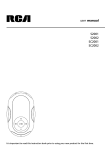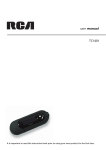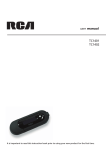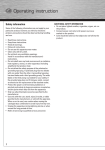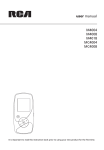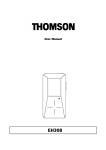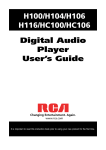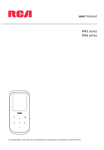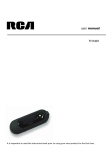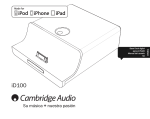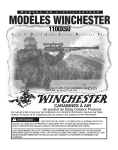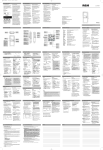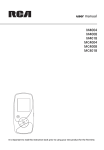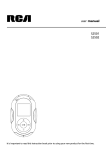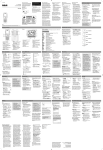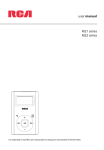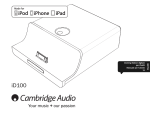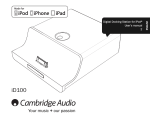Download Owner/User Manual
Transcript
user manual MC5102 MC5104 It is important to read this instruction book prior to using your new product for the first time. Table of Contents Important Information ............................................................................................................................... 4 End User License Agreement ..................................................................................................................... 6 Before You Begin ........................................................................................................................................ 8 Unpacking your player ..................................................................................................................... 8 Things to consider before you get started... .................................................................................. 9 Computer system requirements ............................................................................................ 9 Secure music download requirements ................................................................................. 9 Warning .................................................................................................................................. 9 Caution ................................................................................................................................... 9 Caution while driving .......................................................................................................... 10 Back up your data ................................................................................................................ 10 Software Setup ......................................................................................................................................... 11 Inserting the included CD-ROM into CD-ROM drive .................................................................... 11 Connecting to the Computer ................................................................................................................... 12 Connecting to the computer ......................................................................................................... 12 Charging the battery ..................................................................................................................... 13 Important battery information ........................................................................................... 13 Caution ................................................................................................................................. 13 Transferring Files to the Player ................................................................................................................ 14 Transferring files via Yahoo! MusicTM Jukebox (Windows XP or higher only) ............................ 15 Transferring files via Windows Explorer (drag-and-drop) ........................................................... 16 Disconnecting your player from the computer ............................................................................ 17 General Controls ....................................................................................................................................... 18 Before you begin ............................................................................................................................ 18 Overview of the general controls ................................................................................................. 19 Navigation display .......................................................................................................................... 21 Navigation menus .......................................................................................................................... 22 Selecting what you want to play .................................................................................................. 22 Listening, Viewing and Recording .......................................................................................................... 24 Music/audiobooks playback ........................................................................................................... 24 Music/audiobooks playback display .............................................................................................. 25 Picture viewing ............................................................................................................................... 26 Video viewing ................................................................................................................................. 27 Video converter .............................................................................................................................. 28 Radio (switching on) ...................................................................................................................... 30 Radio (switching off) ...................................................................................................................... 30 Radio operations ............................................................................................................................ 31 Automatic station search .................................................................................................... 31 Saving preset stations .......................................................................................................... 31 Selecting preset stations ...................................................................................................... 31 Clearing preset stations ....................................................................................................... 31 Suppressing stereo signal .................................................................................................... 31 2 Table of Contents Radio recording .............................................................................................................................. 32 Record duration ................................................................................................................... 32 Listening to radio recording ............................................................................................... 32 Deleting radio recording ..................................................................................................... 32 Voice recording .............................................................................................................................. 33 Record duration ................................................................................................................... 34 Listening to voice recording ................................................................................................ 34 Deleting voice recording ..................................................................................................... 34 Line-in recording ............................................................................................................................ 35 Record duration ................................................................................................................... 36 Listening to line-in recording .............................................................................................. 36 Deleting line-in recording ................................................................................................... 36 Playlists ..................................................................................................................................................... 37 My Selections .................................................................................................................................. 37 Clearing My Selections ................................................................................................................... 37 Playlists from your computer ......................................................................................................... 38 Deleting playlists ............................................................................................................................ 38 Player’s Menus .......................................................................................................................................... 39 Accessing the player’s menus ........................................................................................................ 39 Navigation and selections .............................................................................................................. 39 Go to ..................................................................................................................................... 39 Shuffle .................................................................................................................................. 39 Repeat .................................................................................................................................. 40 DSP ........................................................................................................................................ 40 Slideshow ............................................................................................................................. 40 Settings ................................................................................................................................. 40 System info ........................................................................................................................... 40 Additional Information ............................................................................................................................ 41 Tips and troubleshooting ............................................................................................................... 41 Specifications .................................................................................................................................. 43 Hardware .............................................................................................................................. 43 Mass storage drive ............................................................................................................... 43 Software ............................................................................................................................... 43 Miscellaneous specifications ............................................................................................... 43 Check for updates .......................................................................................................................... 43 Limited warranty ............................................................................................................................ 44 3 Important Information WARNING To reduce the risk of fire or electric shock, do not expose this product to rain or moisture. CAUTION RISK OF ELECTRIC SHOCK DO NOT OPEN To reduce the risk of electric shock, do not remove cover (or back). No user serviceable parts inside. Refer servicing to qualified service personnel. This symbol indicates "dangerous voltage" inside the product that presents a risk of electric shock or personal injury. This symbol indicates important instructions accompanying the product. To reduce risk of injury, charge only rechargeable batteries recommended by the manufacturer for this player. Other types of batteries may burst causing damage and personal injury. Technical specification Product: Lyra player Brand: Lyra Model: MC5102 / MC5104 Electrical rating DC : 3.7 V Li-polymer battery (built-in) Lyra MC5102 Equipment tested for compliance as a complete unit Lyra MC5104 Equipment tested for compliance as a complete unit 4 Important Information FCC Regulations state that unauthorized changes or modifications to this equipment may void the user’s authority to operate it. FEDERAL COMMUNICATIONS COMMISSION INFORMATION This device complies with Part 15 of the FCC Rules. Operation is subject to the following two conditions: (1) This device may not cause harmful interference, and (2) this device must accept any interference received, including interference that may cause undesired operation. In accordance with FCC requirements, changes or modifications not expressly approved by Thomson Inc. could void the user’s authority to operate this product. This equipment has been tested and found to comply with the limits for a Class B digital device, pursuant to Part 15 of FCC Rules. These limits are designed to provide reasonable protection against harmful interference in a residential installation. This equipment generates, uses, and can radiate radio frequency energy and, if not installed and used in accordance with the instructions, may cause harmful interference to radio communications. However, there is no guarantee that interference will not occur in a particular installation. If this equipment does cause harmful interference to radio or television reception, which can be determined by turning the equipment off and on, the user is encouraged to try to correct the interference by one or more of the following measures • Reorient or relocate the receiving antenna. • Increase the separation between the equipment and receiver. • Connect the equipment into an outlet on a circuit different from that to which the receiver is connected. • Consult the dealer or an experienced radio/ TV technician for help. Also, the Federal Communications Commission has prepared a helpful booklet, “How To Identify and Resolve Radio TV Interference Problems.” This booklet is available from the U.S. Government Printing Office, Washington, DC 20402. Please specify stock number 004-00000345-4 when ordering copies. This Class B digital apparatus complies with Canadian ICES-003. Cet appareil numérique de la class B est conforme à la norme du NMB-003 du Canada 5 End User License Agreement IMPORTANT: READ CAREFULLY BEFORE DOWNLOADING OR INSTALLING THIS SOFTWARE! THIS END USER LICENSE AGREEMENT (THIS “EULA”) IS A LEGAL AGREEMENT BETWEEN YOU AND THOMSON INC., OR ANY THOMSON GROUP ENTITY, AS DEFINED BELOW (COLLECTIVELY “THOMSON ENTITY”), FOR THE RCA OR THOMSON BRANDED PORTABLE DIGITAL AUDIO/VIDEO DEVICE APPLICATION/DRIVER SOFTWARE PROGRAM AND ASSOCIATED DOCUMENTATION, IF ANY (COLLECTIVELY, THE “PROGRAM”). THIS EULA CONTAINS IMPORTANT LEGAL LIMITATIONS, RESTRICTIONS AND DISCLAIMERS, AND ALSO SPECIFIES THE DURATION OF YOUR LICENSE. BY INSTALLING THE PROGRAM OR CLICKING ON THE ACCEPTANCE BUTTON OF THE PROGRAM, COPYING OR OTHERWISE USING THE PROGRAM, YOU ACKNOWLEDGE AND AGREE THAT YOU HAVE READ THIS EULA, UNDERSTAND IT, AND AGREE TO BE BOUND BY ITS TERMS AND CONDITIONS. YOU MAY USE THE PROGRAM ONLY IN ACCORDANCE WITH THIS EULA, AND ANY SUCH USE IS HEREBY UNDERSTOOD TO BE CONDITIONAL UPON YOUR SPECIFIC AGREEMENT TO THE UNMODIFIED TERMS SET FORTH HEREIN. IF YOU DO NOT AGREE WITH ALL OF THE TERMS OF THIS EULA, CLICK ON THE REJECTION BUTTON AND/OR DO NOT INSTALL THE PROGRAM AND/OR DO NOT USE THE PROGRAM. 1. LICENSE (a) Under this EULA, you are granted a license (i) to use the Program on a single workstation, and (ii) to make one (1) copy of the Program into any machine-readable form for backup of the Program, provided the copy contains all of the original Program's proprietary notices. (b) You may transfer the Program and license to another party only as a part of the Thomson/RCA branded Portable Digital Audio/Video Device (“A/V Device”), and only if the other party agrees to accept the terms and conditions of this EULA. If you transfer the Program, you must at the same time either transfer all copies to the same party or destroy any copies not transferred. (c) The terms of this EULA will govern any software upgrades or updates provided by THOMSON Entity that replace and/or supplement the original Program, unless such upgrade or update is accompanied by separate license terms and conditions in which case the terms of that separate license will govern. You acknowledge and agree that THOMSON Entity may automatically download upgrades or updates to the Program software to your computer in order to update, enhance, and/or further develop the Program. 2. LICENSE RESTRICTIONS (a) Except for the licenses expressly granted to you in this EULA, no other licenses or rights are granted or implied. (b) You may not (i) make the Program available over a network where it could be used by multiple computers at the same time; (ii) modify, translate, reverse engineer, decompile, disassemble (except to the extent that this restriction is expressly prohibited by law), or create derivative works based upon the Program; or (iii) copy the Program, except as expressly permitted herein. You agree that you shall only use the Program in a manner that complies with all applicable laws in the jurisdictions in which you use the Program, including, but not limited to, applicable restrictions concerning copyright and other intellectual property rights. (c) The Program may contain pre-release code that does not perform at the level of a final code release. In such case, the 6 Program may not operate properly. Updated versions of the Program may be downloaded from www.rcaaudiovideo.com/ digitalaudiosupport. (d) THOMSON Entity is not obligated to provide support services for the Program. (e) The Program is provided with “RESTRICTED RIGHTS”. Use, duplication, or disclosure by the U.S. Government is subject to restrictions as set forth in subparagraph (c)(1)(ii) of DFARS 252.227-7013, or FAR 52.227-19, or in FAR 52.227-14 Alt. III, as applicable. 3. TERM AND TERMINATION (a) Your license is effective on the date you accept this EULA and remains in effect until this EULA is terminated by either party. (b) You may terminate this EULA and the associated license, without any notice or delay, by destroying or permanently erasing the Program and all copies thereof. (c) If you fail to comply with any of the terms of this EULA, in whole or part, your license will automatically terminate without notice from THOMSON Entity. (d) Upon termination of this EULA and your associated license, you shall cease all use of the Program and destroy or permanently erase the Program and all full or partial copies thereof. 4. WARRANTY DISCLAIMER THE PROGRAM IS PROVIDED “AS IS” WITHOUT WARRANTY OF ANY KIND, EITHER EXPRESSED OR IMPLIED, INCLUDING, BUT NOT LIMITED TO THE IMPLIED WARRANTIES OF MERCHANTABILITY, FITNESS FOR A PARTICULAR PURPOSE, TITLE OR NON-INFRINGEMENT. THE ENTIRE RISK AS TO THE QUALITY AND PERFORMANCE OF THE PROGRAM IS WITH YOU. SHOULD THE PROGRAM PROVE DEFECTIVE, YOU (AND NOT THOMSON ENTITY, ITS SUPPLIERS, OR ITS DEALERS) ASSUME THE ENTIRE COST FOR ALL NECESSARY REPAIR OR CORRECTION. This exclusion of warranty may not be allowed under some applicable laws. As a result, the above exclusion may not apply to you, and you may have other rights depending on the law that applies to you. 5. OWNERSHIP RIGHTS All title and intellectual property rights in and to the Program and any copies thereof are owned by THOMSON Entity or its suppliers. All title and intellectual property rights in and to the content which may be accessed through use of the Program is the property of the respective content owner and may be protected by applicable copyright or other intellectual property laws and treaties. This license grants you no rights to use such content. 6. LIMITATION OF LIABILITY (a) TO THE MAXIMUM EXTENT PERMITTED BY APPLICABLE LAW, IN NO EVENT SHALL THOMSON ENTITY, OR ITS DEALERS BE LIABLE FOR ANY SPECIAL, INCIDENTAL, INDIRECT, OR CONSEQUENTIAL DAMAGES WHATSOEVER (INCLUDING, WITHOUT LIMITATION, DAMAGES FOR LOSS OF PROFITS, BUSINESS INTERRUPTION, CORRUPTION OF FILES, LOSS OF BUSINESS INFORMATION, OR ANY OTHER PECUNIARY LOSS) REGARDLESS OF CAUSE OR FORM OF ACTION, INCLUDING CONTRACT, TORT, OR NEGLIGENCE, ARISING OUT OF YOUR USE OF OR INABILITY TO USE THE PROGRAM, EVEN IF THOMSON ENTITY HAS BEEN ADVISED OF THE POSSIBILITY OF SUCH DAMAGES. BECAUSE SOME STATES AND JURISDICTIONS DO End User License Agreement NOT ALLOW THE EXCLUSION OR LIMITATION OF LIABILITY OF CONSEQUENTIAL OR INCIDENTAL DAMAGES, THE ABOVE LIMITATION MAY NOT APPLY TO YOU. (b) YOU ASSUME RESPONSIBILITY FOR THE SELECTION OF THE APPROPRIATE PROGRAM TO ACHIEVE YOUR INTENDED RESULTS, AND FOR THE INSTALLATION, USE, AND RESULTS OBTAINED. 7. WINDOWS MEDIA The software embedded within your A/V Device (the “Device Firmware”) contains software licensed from Microsoft that enables you to play Windows Media Audio (WMA) files (“WMA Software”). The WMA Software is licensed to you for use with your A/V Device under the following conditions. By installing and using this version of the Device Firmware, you are agreeing to these conditions. IF YOU DO NOT AGREE TO THE END USER CONDITIONS OF THIS SECTION 7, DO NOT INSTALL OR USE THIS VERSION OF THE DEVICE FIRMWARE. The WMA Software is protected by copyright and other intellectual property laws. This protection also extends to documentation for the WMA Software, whether in written or electronic form. GRANT OF LICENSE. The WMA Software is only licensed to you as follows: You may use this version of the Device Firmware containing the WMA Software only as such use relates to your A/V Device. You may not reverse engineer, decompile, or disassemble the WMA Software, except and only to the extent that such activity is expressly permitted by applicable law. You may transfer your right to use the Device Firmware only as part of a sale or transfer of your A/V Device, on the condition that the recipient agrees to the conditions set forth herein. If the version of the Device Firmware that you are transferring is an upgrade, you must also transfer all prior versions of the Device Firmware that you have which include the WMA Software. MICROSOFT IS NOT PROVIDING ANY WARRANTY OF ANY KIND TO YOU FOR THE WMA SOFTWARE, AND MICROSOFT MAKES NO REPRESENTATION CONCERNING THE OPERABILITY OF THE WMA SOFTWARE. The WMA Software is of U.S. origin. Any export of this version of the Device Firmware must comply with all applicable international and national laws, including the U.S. Export Administration Regulations, that apply to the WMA Software incorporated in the Device Firmware. Content providers are using the digital rights management technology for Windows Media contained in your A/V Device (“WM-DRM”) to protect the integrity of their content (“Secure Content”) so that their intellectual property, including copyrights, in such content is not misappropriated. Your A/V Device uses WM-DRM software to play Secure Content (“WMDRM Software”). If the security of the WM-DRM Software in your A/V Device has been compromised, owners of Secure Content (“Secure Content Owners”) may request that Microsoft revoke the WM-DRM Software’s right to acquire new licenses to copy, display, and/or play Secure Content. Revocation does not alter the WM-DRM Software's ability to play unprotected content. A list of revoked WM-DRM Software is sent to your A/V Device whenever you download a license for Secure Content from the Internet or from a computer. Microsoft may, in conjunction with such license, also download revocation lists onto your A/V Device on behalf of Secure Content Owners. 8. THIRD PARTY SOFTWARE ANY THIRD PARTY SOFTWARE THAT MAY BE PROVIDED WITH THE PROGRAM IS INCLUDED FOR USE AT YOUR OPTION. IF YOU CHOOSE TO USE SUCH THIRD PARTY SOFTWARE, THEN SUCH USE SHALL BE GOVERNED BY SUCH THIRD PARTY'S LICENSE AGREEMENT, AN ELECTRONIC COPY OF WHICH WILL BE INSTALLED IN THE APPROPRIATE FOLDER ON YOUR COMPUTER UPON INSTALLATION OF THE SOFTWARE. THOMSON ENTITY IS NOT RESPONSIBLE FOR ANY THIRD PARTY’S SOFTWARE AND SHALL HAVE NO LIABILITY FOR YOUR USE OF THIRD PARTY SOFTWARE. 9. GOVERNING LAW If you acquired this A/V Device in the United States, this EULA shall be governed and construed in accordance with the laws of the State of Indiana, U.S.A. without regard to its conflict of laws principles. If you acquired this A/V Device outside the United States or the European Union, then local law may apply. 10. GENERAL TERMS This EULA can only be modified by a written agreement signed by you and THOMSON Entity, and changes from the terms and conditions of this EULA made in any other manner will be of no effect. If any portion of this EULA shall be held invalid, illegal, or unenforceable, the validity, legality, and enforceability of the remainder of the Agreement shall not in any way be affected or impaired thereby. This EULA is the complete and exclusive statement of the agreement between you and THOMSON Entity, which supersedes all proposals or prior agreements, oral or written, and all other communications between you and THOMSON Entity, relating to the subject matter of this hereof. “THOMSON Group Entity” when used in this EULA shall mean any person, corporation, or other organization, domestic or foreign, including but not limited to subsidiaries, that is directly or indirectly controlled by Thomson S.A. For purposes of this definition only, the term “control” means the possession of the power to direct or cause the direction of the management and policies of an entity, whether by ownership of voting stock or partnership interest, by contract, or otherwise, including direct or indirect ownership of more than fifty percent (50%) of the voting interest in the entity in question. 7 Before You Begin Dear RCA Customer, Thank you for purchasing the RCA Player. This player will play open mp3 and Windows Media™ audio (WMA) content as well as content purchased from most online music download services. After purchasing and downloading music to your PC, you are now ready to move content to your player. To transfer the music to your player, you may use Yahoo! Music™ Jukebox or the application recommended by the online music download service. (Note: Services and applications must be Windows Media audio-compliant and support Digital Rights Management. Windows XP (SP1 or higher) required.) Unpacking your player Your player came with everything you need to make music portable — all of the items shown below should have been packed in the box with your player. RCA Player Music Management CD Contains software applications Mini USB cable Plug the small end into the USB on your player, and plug the other end into your computer’s USB port. Earphones Line-in cable Carrying pouch Explore a world of accessories! Jump on the Internet and go to www.rcaaudiovideo.com to discover the additional accessories that are available for your player. Illustrations contained within this publication are for representation only and subject to change. 8 Before You Begin Things to consider before you get started... Computer system requirements • • • • • • • • • • Pentium III 500MHz or higher recommended Windows XP SP1 (SP= Service Pack) or higher. Internet Explorer 6.0 or higher Internet access (broadband recommended) 250MB free hard disk space for the software 128MB RAM (256MB recommended) CD drive capable of digital audio extraction USB port (2.0 recommended) Sound card 16- bit color video card Secure music download requirements • Windows XP SP1 or higher (SP=Service Pack) • Internt Explorer 6.0 or higher • Windows Media Player 10 or higher Warning Use of this player is for your personal use only. Unauthorized recording or duplication of copyrighted material may infringe upon the rights of third parties and may be contrary to copyright laws. Caution • Keep player out of direct sunlight. Exposure to direct sunlight or extreme heat (such as inside a parked car) may cause damage or malfunction. • Do not expose to rain or moisture. 9 Before You Begin Caution while driving Use of headphones while operating an automobile or moving vehicle is not recommended and is unlawful in some states and areas. Be careful and attentive on the road. Stop operation of the player if you find it disruptive or distracting while driving. Back up your data As with any portable player that has a hard drive, you must back up the drive regularly. RCA and Thomson are not responsible for lost data. 10 Software Setup The Music Management CD that comes with your player contains all of the necessary software components you need to make your player work properly. These components do the following: • enable you to transfer files from your computer to your player, • convert video files and/or automatically update the player (if included on the CD). Inserting the included CD into CD drive 1. Turn on your computer and place the Music Management CD that came with your player into your computer. 2. If the setup screen does not appear, double-click My Computer, double click your CD drive icon, and double click Install to run the installer. IMPORTANT: Don’t connect the USB cable to the PC or the player before or during the CD installation. Note: The Music Management CD also contains Yahoo! MusicTM Jukebox that can help transfer music content to your player. Please refer to the section on your installed software for detailed operations. Yahoo! MusicTM Jukebox is supported only in Windows XP or higher operating system. 11 Connecting to the Computer Connecting the player to the computer Connect the player to your computer with the mini USB cable provided. The player will turn on automatically. The player will appear as a Windows portable device (Windows XP) using the Media Transfer Protocol (MTP). The Player USB port of your computer USB cable • It might take several seconds for the player to be detected. Click Refresh in My Computer or Windows Explorer to make sure the player has been detected. • The player is capable of transferring files at USB 2.0. If a USB 2.0 port is available on your computer, use it to connect to your player. The player is still backward compatible with the older USB 1.1 ports. However, you will not be able to take full advantage of the potential speed increase. Note: Windows XP requires Service Pack 1 or higher. 12 Connecting to the Computer Charging the battery Your player is charged through the USB connection when it is connected to your computer. To fully charge the player, make sure your computer is on and the player is connected for at least 3 hours. Important battery information • Charge the player for at least 3 hours before first use. • Charge the player for at least 3 hours after putting away the player for a long time. • Battery replacement should only be made by trained technicians. Refer to Limited Warranty for details. • Do not attempt to open the player. No user serviceable parts inside. • To reduce risk of injury, charge only rechargeable batteries recommended by the manufacturer for this player. Other types of batteries may burst causing damage and personal injury. Caution • The battery used in this player may present a risk of fire, explosion, or chemical burn if mistreated. Do not separately recharge, disassemble, or expose to high temperatures. Examples of high temperatures that may damage your product include leaving it in a locked car in the summer, or putting it on top of other heat generating electronic devices (such as power amplifiers and computer monitors). • Do not place the battery under direct sunlight or in excessively hot places over 45ºC (113ºF) such as the dashboard of car. • Dispose of used battery properly. Keep away from children. Do not disassemble and do not dispose of in fire. Caution • Risk of explosion if battery is replaced by an incorrect type. • Dispose of used batteries according to the instructions. 13 Transferring Files to the Player Transferring files to the player You may select one of the following methods to transfer music contents to your player: 1) Yahoo! MusicTM Jukebox, 2) drag-and-drop via Windows Explorer. For method 1, you first need to have successfully installed the software packages included in the Music Management CD (refer to “Inserting the included CD into CD drive). • Transferring Files via Yahoo! MusicTM Jukebox - refer to page 15 • Transferring files via Windows Explorer (drag-and-drop) - refer to page 16 Note: Yahoo! Music Jukebox is supported only in Windows XP or higher operating system. Caution: Secure music download files must be transferred to your player through the Yahoo MusicTM Jukebox or the application recommended by your online music download service (Note: Services and applications must be Windows Media audio-compliant and support Digital Rights Management.) (Apple iTunesTM music content is not supported). 14 Transferring Files to the Player Transferring files via Yahoo! MusicTM Jukebox (Windows XP or higher only) Yahoo! MusicTM Jukebox lets you manage your music easily and organize like a pro. Create your own playlists: music for work, the gym, or even dinner. You can also buy download music and transfer to your player in seconds. Just drag and drop and you’re done. For more information on the installation and operations, please visit: http://music.yahoo.com Do not disconnect the USB cable during music download. Doing so may corrupt system files or the files being downloaded. 1. Launch the Yahoo! Music Jukebox. 2. Attach the player to your computer. The player’s name should appear after a few seconds in the left navigation pane. 3. In the Yahoo! MusicTM Jukebox, click My Music or click on a playlist on the left navigation pane. 4. Simply drag the playlist you want to the name of your player in the left navigation pane (you can also drag tracks, artists and albums directly from My Music). 5. The Yahoo! MusicTM Jukebox will check to see if there is sufficient storage space on the player to copy the songs. If not, you will have to reduce the number of songs you are transferring. • Yahoo! MusicTM Jukebox is supported only in Windows XP or higher operating system and Internet Explorer 6 or above for installation. • Required updates to Yahoo! MusicTM Jukebox may be available from Yahoo! after installation. Please refer to the Yahoo! MusicTM Jukebox Help for more information about these updates. 15 Transferring Files to the Player Transferring files via Windows Explorer (drag-and-drop) (Windows XP only) In Windows Explorer, when the RCA player is opened in MTP mode, and Windows Media Player 10 is installed, the “Data” and “Media” views will be displayed for the player. The Data folder is used to manage data content on the player, such as text files. The Media folder is used to manage media content supported by the player for playback, such as mp3 and wma. You can copy / delete files from the player through Windows Explorer, but you cannot open or edit the files directly from the player. If you want to edit the files, you will need to copy the files from the player to another location (drive) in the system. Note: • Picture files should be copied to the “Media” folder for viewing. Video files cannot be drag and copied to the “Media” folder. They must be converted and transferred to the player via RCA Video Converter for playback (refer to page 28). • If your computer has installed Windows Media Player 11, “Internal Storage” shows instead of the folders mentioned above. Copy files inside “Internal Storage”. Caution: Secure music download files must be transferred to your player through one of the provided Jukebox software packages or any applications recommended by the online music download service. Please visit the online music download service’s website where you purchased your content from for more details on transferring secure music to your player. Note: Windows XP requires Service Pack 1 or higher. 16 Transferring Files to the Player Disconnecting your player from the computer Do not disconnect the USB connection during file download. Doing so may corrupt system files or the files being downloaded. For Windows XP users, your player is connected in MTP (Media Transfer Protocal) mode to your computer by default, you may disconnect the USB cable directly when file download is completed. 17 General Controls Before you begin The following example illustrates what you should do before operating your player. 1. These instructions presume you’ve already done the followings: • Installed all necessary applications. • Transferred music from your computer to the player. • Allowed your player to charge for at least 3 hours while connected to the computer. 2. If you haven’t unplugged the player from your computer, detach the USB cable from the player. 3. Connect the earphones to your player. 4. If your player isn’t already on, turn it on by sliding the power button downwards and hold it until the player turns on. The main navigation menu appears. 18 General Controls Overview Top view 2 Left view Front view Right view Back view 8 1 3 4 6 5 7 1. Key lock - slide the key upwards to prevent accidental key activation. To unlock, slide the key to the middle position. Power on/off - slide the key downwards and hold it until the player turns on/off. Stop playback - slide the key downwards during music, picture or video playback and then release to stop the playback. 2. Microphone 3. The display 4. M - Enters or exits the player’s menu. (During playback, touch once to access the previous navigation screen before playback, touch twice to access player’s menu. Touch three times to go back to the playback screen.) 19 General Controls 5. Touch sensitive keypad - touch or move your finger along the surface for operations. Scrolls up during menu navigation Scrolls down during menu navigation Skips backward, goes back a level during menu navigation Skips forward, advances a level during menu navigation Starts/ pauses playback, makes selections Moving your finger clockwise along the control pad as seen in the circular arrow will increase the volume. To decrease the volume, just move you finger counterclockwise. 6. USB connector – Attach the small end (Type mini-B) of the mini-USB cable here. Attach the large end (Type A) to your computer’s USB port. The player will enter USB mode automatically, and you can transfer files to and from the computer. The player’s battery will also be charged when connected to the computer. 7. Earphones jack – Insert the earphone plug here. 8. Reset button – If the player locks up, press the reset button with a non-metal pointed object (e.g. toothpick) to reset it. 20 General Controls Navigation display Indicates the mode currently selected 1 2 3 4 5 Indicates the item currently selected 1. 2. 3. 4. 5. Indicates whether the player is playing or paused. Indicates if the shuffle mode is on or off. Indicates what repeat mode is activated or off. Indicates that the key lock function is activated. Indicates the battery level of the player. When charging, the icon will animate. 21 General Controls Navigation menus The files are sorted according to their file types. Music files are further sorted according to several parameters for quickly searching your favourite music. Once your player is turned on, the following file menu parameters can be seen as below: Home Music Audiobooks Radio Recs Voice Recs Line-in Recs Playlists Pictures Video Artists Albums Titles Genres Years Selecting what you want to play The following example illustrates the steps to select and play songs in the Artists category. 1. Select “Music” by touching advance. or . Then touch to Music 22 Music Artists Albums Tiltes Geners Years 2. Highlight “Artists” by touching Artists Artist 1 Artist 2 Artist 3 Artist 4 Artist 5 Artist 6 3. The Artists menu appears with the artists listed in alphabetical order. • Scroll up and down the “Artists” menu by touching or . or . Then touch to advance. • Return to the previous menu by touching . • View the albums from the artist highlighted by touching (the albums of that artist appear in alphabetical order). General Controls Artist 3 All Songs Album 1 Album 2 Album 3 Album 4 Album 5 4. Scroll up and down the “Albums” menu by touching or . • View the songs from the album highlighted by touching Album 4 All Songs Song 1 Song 2 Song 3 Song 4 Song 5 5. Highlight the desired song by touching (the songs of that album appear in track order). or . • To play the song, touch or . The song’s information will show on the display during playback. • To pause playback, touch . Note: • The information provided in the playback screen depends upon the metadata fields that have been set up for the song. • To show the player’s menu at any stage of navigation, touch M. • The item that you can select for playback does not limit to a single file, you may select an artist, an album and then touch to start playback of all files within your selected item. 23 Listening, Viewing and Recording Music/Audiobooks playback Shows Album Art of digital music* Shows Album Art of digital music* Skips to the previous file**, touch and hold to scan backward within a file. Skips to the next file, touch and hold to scan forward within a file. Starts/ pauses playback, touch and hold to add the current file (music only) in MySelections. Increase or decrease the volume. Moving your finger clockwise along the control pad as seen in the circular arrow will increase the volume. To decrease the volume, just move you finger counter-clockwise. Slide downwards and release to stop playback. For multi-section audiobook files, touch and hold “skipping by file’”and “skipping by section”. Skipping by file - Touch Skipping by section - Touch file. or during playback to select between to go to the previous or next audiobook file. or to go to the previous** or next section of the current * Showing Album Art of digital music - Depending on the format of the music file, album art and the application software used for transferring files to the player, not all different formats of the album art might be supported. For music files with displayed album art, you can select displaying either the album art or the track information by using the up/down button. ** Touch within the beginning 4 seconds of the current music or sectioned audible file to skip to previous file/section. Otherwise, you will return to the beginning of the current file/ section. 24 Listening, Viewing and Recording Music/Audiobooks playback display Read page 21 for details 1 2 3 4 5 6 7 8 9 1. Current file number / total number of files (for audiobooks in “Skipping by Section” mode (refer to the previous page), “Sect” shows before current section number / total number of section) 2. Song name (or title of audiobook) 3. Artist name (or author of audiobook) 4. Album name (or provider of audiobook) 5. Genre type (or category of audiobook) 6. Elapsed playback time 7. Year of the file 8. Playback progress bar 9. File total time • • The information provided in the playback screen depends upon the metadata fields that have been set up for the song/audiobook. If ablum art is available with a music file, touch or to show or hide it. 25 Listening, Viewing and Recording Picture viewing Scrolls up during file navigation. Scrolls down during file navigation. Skips backward. Skips forward. Starts/ pauses slideshow. Increase or decrease the volume. Moving your finger clockwise along the control pad as seen in the circular arrow will increase the volume. To decrease the volume, just move you finger counter-clockwise. M Touch during playback to pause and return to file navigation. Slide downwards and release to stop playback and return to file navigation. Picture files should be copied to the “Media” folder of the player for viewing if your computer has Windows Media Player 10 installed. 26 Listening, Viewing and Recording Video viewing Scrolls up during file navigation. Scrolls down during file navigation. Skips backward*. Touch and hold to scan backwards within a file. * Touch within the beginning 4 seconds of the current file to skip to previous file. Otherwise, you will return to the beginning of the current file. Skips forward. Touch and hold to scan forward within a file. Starts/ pauses playback. Increase or decrease the volume. Moving your finger clockwise along the control pad as seen in the circular arrow will increase the volume. To decrease the volume, just move you finger counter-clockwise. M Touch during playback to return to file navigation. Slide downwards and release to stop playback and return to file navigation. Video files must be converted and transferred by the Video Converter installed from the included CD. Please refer to the following pages for details. 27 Listening, Viewing and Recording Video converter Before transferring any video files to your player, they must be converted to a compatible format for optimal playback. To do so, you need to install the RCA Video Converter in your computer. The video converter only works on Windows XP or higher. 1. Load the music management CD included with this player in your computer. Installation will start automactically. Follow the on screen instructions to properly install the RCA Video Converter. 2. After installation is complete, launch the RCA video converter and connect the player to the computer. 3. Drag-and-drop the selected video files from Windows Explorer onto the Video Converter’s list control. Drag-and-drop here Select the target folder Select the player type • If the video file is already compatible with the player, “Ready to be downloaded” shows under “Status”. 4. Select the target folder you wish to save the converted video file too by clicking "Browse" under the list control. • If you want to transfer the video output file to the player automatically after the conversion is complete, check the box underneath to allow transfer to player when conversion is complete. 5. Select the type of player from the pull-down menu under “Player”. For this player, select “M51 series” in the pull-down menu. Once the type of player is selected, optimum settings for file conversion will be made automatically. 6. To edit the name of the output video, click on the box that is just to the right of the Destination box at the lower right corner of the Video Converter application. 28 Listening, Viewing and Recording 7. If you prefer to convert only a portion of the video file, select the start and end time for conversion by increasing or decreasing the box to the right of Start and End at the lower right corner of the Video Converter application. 8. To rotate the output file by 90O after conversion, select “Yes” from the pull-down menu to the right of "Rotate" at the lower right corner of the Video Converter application. 9. Once all selections and changes above have been made, click “Convert” to start the file conversion. • If all the video files are ready to be downloaded without conversion, the “Convert” button will change to “Download”. Click “Download” to start the file transfer. Tip: For operation details of the video converter, please open the help file by pressing the ‘F1’ key on your computer. Note: If Windows Media Player 10 is installed, picture files should be copied to the“Media” folder for viewing. Video files cannot be dragged and dropped to the “Media” folder. They must be converted and transferred to the player via RCA Video Converter for playback. Alternatively, converted video files can also be transferred via Windows Media Player in the same way as you transfer music files to the player. Please refer to the instructions of Windows Media Player for operation details. This video converter software relies on the video codecs already installed in your computer. Make sure the video file you wish to convert plays on your computer before using the video converter software. Note that some video files that play on your computer may rely on specialized video playback applications that are not compatible with the video converter software. The video converter can only convert files that play on your PC. If a file cannot play on your PC, then it will be necessary for you to download the appropriate PC media player for that file format from the Internet. Enter the file type or file format into a common Internet search engine to find links where the PC media player can be downloaded and installed to your PC. 29 Listening, Viewing and Recording Radio (switching on) 1. To switch on the radio, touch M in any mode to access the player’s menu (during playback M has to be touched twice). Menu Go to Shuffle Repeat DSP Slideshow Settings 2. While “Go to” is highlighted, touch . Off Off Flat Off Go to Radio Voice Recording Line-in Recording 3. While “Radio” is highlighted, touch the radio. to switch on Radio (switching off) 1. To switch off the radio, touch M in the radio mode. Menu Go to Save to Preset Clear Preset Mode Stereo RecDur Max Settings Go to Library Voice Recording Line-in Recording 2. While “Go to” is highlighted, touch . 3. Select one of the modes to switch to and then touch . You may also slide the power key downwards and hold it until the player powers off to turn off the radio. 30 Listening, Viewing and Recording Radio operations Selecting Radio Frequency Touch or to select frequency. Tip: touch and hold or to search the frequency at a faster rate. Automatic station search Touch and hold or in the radio mode until “Searching...” shows on the display. The search will stop when the next available radio station is found. Saving preset stations 1. Select a radio frequency. 2. Touch M and then touch or to highlight “Save to Preset”. 3. Touch or to make the selection. 4. The next available preset station number will show, touch or to select another number if so desired. 5. Touch to save the frequency as the assigned preset station number. Selecting preset stations Touch or in the radio mode to select a preset station. Clearing preset stations 1. Touch or in the radio mode to select an unwanted preset station. 2. Touch M and then touch or to highlight “Clear Preset”. 3. Touch or to delete the unwanted preset station. Suppressing stereo signal If FM stereo reception is weak, select mono sound to reduce the noise. 1. While listening to the radio, touch M and then touch or to highlight “Mode”. 2. Touch or to select between “Mono” and “Stereo” sound. 3. Touch M to exit the player’s menu. 31 Listening, Viewing and Recording Radio recording 1. Touch and hold at any time while listening to the radio to start radio recording. 2. Touch to pause record. Touch again to resume recording. 3. Touch and hold to stop recording. OR Slide the power button downwards and release to stop recording. Record duration You may select the maximum record duration. 1. While listening to the radio, touch M and then touch or to highlight “RecDur”. 2. Touch or to select 5m, 30m, 1h or max (5 min, 30 min, 1 hour and maximum). 3. Touch M to exit the player’s menu. Listening to radio recording 1. In the navigation menu, select “Radio Recs” to show the archive of radio recordings. 2. Select one of the recorded files for listening (refer to page 22 for details). Deleting radio recording 1. In the navigation menu, select “Radio Recs” to show the archive of radio recordings. Select an unwanted recorded file from the archive (refer to page 22 for details). or to highlight “Delete file”. 2. Touch M and then touch 3. Touch 32 or to delete the unwanted file. Listening, Viewing and Recording Voice recording 1. To start voice recording, touch M in any mode to access the player’s menu (during playback M has to be touched twice). Menu Go to Shuffle Repeat DSP Slideshow Settings 2. While “Go to” is highlighted, touch . Off Off Flat Off Go to Radio Voice Recording Line-in Recording 3. Touch Voice Rec 4. Touch and hold when the display shows “Ready” to start voice recording. touch or to highlight “Voice Recording”. Then to access voice recording mode. Ready 5. Touch to pause record. Touch recording. again to resume 6. Touch and hold to stop recording. OR Slide the power button downwards and release to stop recording. 33 Listening, Viewing and Recording Record duration You may select the maximum record duration. 1. In the voice recording mode, touch M and then touch or to highlight “RecDur”. 2. Touch or to select 5m, 30m, 1h or max (5 min, 30 min, 1 hour and maximum). 3. Touch M to exit the player’s menu. Listening to voice recording 1. In the navigation menu, select “Voice Recs” to show the archive of voice recordings. 2. Select one of the recorded files for listening (refer to page 22 for details). Deleting voice recording 1. In the navigation menu, select “Voice Recs” to show the archive of voice recordings. Select an unwanted recorded file from the archive (refer to page 22 for details). 2. Touch M and then touch or to highlight “Delete file”. 3. Touch 34 or to delete the unwanted file. Listening, Viewing and Recording Line-in recording 1. To start line-in recording, touch M in any mode to access the player’s menu (during playback M has to be touched twice). Menu Go to Shuffle Repeat DSP Slideshow Settings 2. While “Go to” is highlighted, touch Off Off Flat Off Go to Radio Voice Recording Line-in Recording Line-in Rec . 3. Touch or Then touch to highlight “Line-in Recording”. to access the line-in recording mode. 4. Touch and hold when the display shows “Ready” to start line-in recording. Ready 5. Touch to pause record. Touch recording. again to resume 6. Touch and hold to stop recording. OR Slide the power button downwards and release to stop recording. Adjust the volume level of the source audio device in order to achieve the optimum recording quality. The source output varies from model to model. You might want to experiment with a few recordings to determine the proper volume output of the source to get optimum recording quality from the player. Recommend starting the source at around room volume level. 35 Listening, Viewing and Recording Record duration You may select the maximum record duration. 1. In the line-in recording mode, touch M and then touch or to highlight “RecDur”. 2. Touch or to select 5m, 30m, 1h or max (5 min, 30 min, 1 hour and maximum). 3. Touch M to exit the player’s menu. Listening to line-in recording 1. In the navigation menu, select “Line-in Recs” to show the archive of line-in recordings. 2. Select one of the recorded files for listening (refer to page 22 for details). Deleting line-in recording 1. In the navigation menu, select “Line-in Recs” to show the archive of line-in recordings. Select an unwanted recorded file from the archive (refer to page 22 for details). 2. Touch M and then touch or to highlight “Delete file”. 3. Touch 36 or to delete the unwanted file. Playlists My Selections My Selections is a playlist containing your favorite songs, albums, artists from the player. Audiobook and recorded files cannot be selected as My Selections. Album 4 Song 1 Song 2 Song 3 Added to My Sel Song 4 Song 5 Song 6 1 Highlight the desired song, artist, album etc. and then touch and hold until “Added to My Sel” shows on the display. Repeat this step for selecting more items. • You may select an item as My Selections as many times as you want, even if it has already been selected. If your selected item is an artist, an album etc., all files within will be selected as My Selection. 2. In the home menu, select “Playlists” by touching . Then touch Playlists Playlists My Selections Playlist 1 or to enter the Playlists menu. 3. “My Selections” is already selected, touch to start playback of the songs in the My Selection playlist. Clearing My Selections 1. In the home menu, select “Playlists” by touching . Then touch or to enter the Playlists menu. 2. “My Selections” is already selected, touch M to to show the player’s menu. Menu Go to Clear Playlist Shuffle Repeat DSP 3. Highlight “Clear Playlist” by touching then touch . and Off Off Flat 4. Highlight “Yes” by touching to confirm clearing. ? YES or or and then touch NO 37 Playlists Playlists from your computer The created playlists from major music management softwares on your computer (e.g. Yahoo! MusicTM Jukebox, Windows Media Player) can be transferred to the player while you transfer music files via these softwares. Follow the steps below to play them. 1. In the home menu, select “Playlists” by touching or . Then touch to enter the Playlists menu. Playlists 2. Highlight a playlist by touching or . Touch to start playback of the selected playlist. Playlists My Selections Playlist 1 Playlist 2 Playlist 3 Deleting playlists 1. In the home menu, select “Playlists” by touching or . Then touch to enter the Playlists menu. Playlists 2. Highlight an unwanted playlist by touching or and then touch M to show the player’s menu. Playlists My Selections Playlist 1 Playlist 2 Playlist 3 Menu Go to Delete Playlist Shuffle Repeat DSP Slideshow 3. Highlight “Delete Playlist” by touching or touch to confirm deletion of the selected playlist. Off Off Flat Off 4. Highlight “Yes” by touching touch to confirm deletion. ? YES 38 NO or and then , Player’s Menus Accessing player’s menus Touch M in any mode to access the player’s menu. During playback M has to be touched twice to display the player’s menu. Player’s menus Library Radio Voice Recording Line-in Recording Go to Shuffle Repeat DSP Slideshow Settings System Info Customize Menu Brightness Screensaver Power Save Sleep FreqStep Language Restore Defaults Navigation and selection Player’s Menu items Menu Go to Shuffle Repeat DSP Slideshow Settings Off Off Flat Off 1. To scroll up or down to highlight items on the screen, touch 2. To enter and view the submenu, touch or 3. To go back to the previous menu level, touch Currently selected option or . . . Go to Touch or to switch among the library, radio, voice and line-in recording modes. Shuffle Touch or to select shuffle on or off. Files will be played randomly when shuffle is activated. This item is only available when you are listening to a music (mp3 or wma) file. 39 Player’s Menus Repeat Touch or to select a repeat mode. This item is only available when you are listening to a music (mp3 or wma) file. • Repeat One - Repeat the current item • Repeat All - Repeat all items. • Repeat Off - Repeat is Off. Repeat and shuffle will work differently if you have highlighted a song or a set (albums, genres, etc.). You can select your desired combination of Shuffle and Repeat to suit you. DSP (Digital Signal Processor) Touch (touch Touch or to select a DSP mode. Options available: flat, Bass, Pop, Rock, Jazz and Graphic to enter graphic mode). In graphic mode, you can customize the 5 band equalizer. or to select a band and then touch or to adjust the band level. Slideshow The item defines the viewing time for each picture during a slideshow. Touch among: off, 3, 5, 10 and 15 seconds. or to select Settings Touch or to enter the Settings menu and then touch the player for options available within each item. • • • • • • • • or to select an item. Refer to Customize Menu: to customize the music menu to show and hide certain menu items. Brightness: to adjust the display light brightness. Screensaver: to adjust the duration before the screensaver activates. Power Save: to adjust the duration for automatic shut down when the player is idle. Sleep: to adjust the duration of playback before automatic shut down. FreqStep (Frequency Step): to select between the US and Europe frequency mode. Language: to select the menu’s language. Restore Defaults: to reset all menus to factory defaults. System info Touch 40 or to show the amount of free space available and the firmware version. Additional Information Tips and troubleshooting • Problem: Player repeats same tracks or all tracks. – Repeat play is turned on. Touch the MENU button (M) to change the play mode. • Problem: Audio distorted at high volume. – Select another DSP setting. – Turn down the volume. • Problem: The audio tracks on my player keep skipping or popping. – You’ll need to re-record the audio track – make sure you close all other applications on your PC when you record. – Try recording with Error Correction setting turned on. • Problem: Player turns itself off. – Your player turns itself off if you leave it in pause mode or navigation mode for the duration specified in PowerSave setting. • – – – Problem: The player cannot be turned on. Reset the player by pressing the RESET button. If the player still cannot be turned on after resetting, perform a firmware upgrade to restore it. Please go to http://www.rcaaudiovideo.com for more details. • Problem: Player does not respond to key presses. – The key lock may be active. Unlock by sliding the power key to the middle position. – If your player stops responding to key presses, you can reset it by pressing the RESET button with a non-metal pointed object (e.g. toothpick). Most of your settings will be preserved; only the settings that you have changed after your last power off will be lost. – This player may temporarily cease to function if subjected to electrostatic disturbance. To resume normal operation, it may be necessary to cycle the power off and back on or you can reset it by pressing the RESET button with a non-metal pointed object (e.g. toothpick). • Problem: Player cannot play WMA songs. – Secure music download files must be transferred to your player through the Yahoo! MusicTM Jukebox or the application recommended by your online music download service (Note: Services and applications must be Windows Media audio-compliant and support Digital Rights Management.) (Apple iTunesTM music content is not supported). • Problem: The player takes a long time to read files in a folder. – File reading may take longer if too many files are put in a single folder. Re-organize your files into a number of folders. • Problem: Why song information is not showing correctly? – Song information may not match your current player’s language setting. Change the language setting. 41 Additional Information • Why can I not view picture files on my player? – The player only supports .jpg extension file, and does not support other formats like .bmp, .tiff, .jpeg. – All picture files need to be put in the \Media folder of the player (if Windows Media Player 10 installed). • Why does my player not play the video files that were transferred from the computer? – All video files must be converted by the video converter which comes with the player (please refer to the CD). Other video file formats are not supported. • Why does my player report that it is full? – You have filled the capacity of the player’s memory. – You have exceeded the maximum number of items that this player supports. Your player can only support up to 2000 files and folders on the player. • Problem: Contents transferred to my player doesn’t show up on other computers. – For Windows XP users with Windows Media Player 10 installed, your player is connected in MTP mode to PC by default, those contents transferred in MTP mode can only be seen on a PC with Windows XP and connected in MTP mode. • Problem: Cannot playback tracks on the player. – Make sure audio tracks are encoded in the mp3 or Windows Media formats at supported bitrates. Bitrates support by the player: mp3 – 32 to 320 kbps wma – 48 to 192 kbps – WMA files may be DRM protected and you don’t have the proper rights (license) to play the files. – Check the website and/or application help system of the music download service provider from where the content was purchased from for license acquisition details. For more information on how license acquisition works, go to www.microsoft.com/windowsmedia/drm. • What is MTP mode? – MTP (Media Transfer Protocol) mode is essential if you want to transfer DRM content to your player. In MTP mode your player will no longer show up as a drive letter. So programs that were designed to work with a player that shows up as a drive letter will not be able to work directly with the player. 42 Additional Information Specifications Hardware • Dimensions: 91 mm H, 40.7 mm W, 7.5 mm D • Unit Weight: 55 g • Stereo Headphones Jack • Mini USB Connection Jack • Battery Operated: Rechargeable lithium polymer battery. Mass storage drive • External mass storage drive: When connected to a computer via USB, the player is capable of storing any file type allowing the user a fast, convenient method of storing, retrieving, and transferring files. This includes word processing files, presentations, spreadsheets and any other computer files. • Capacity: MC5102 - 2 GB, MC5104 - 4GB • Connection: USB 2.0, Hi-speed capable Software • Includes the player applications and media management software. Miscellaneous specifications • Signal to Noise Ratio (>85dB) A-weighted • THD (<1.0%) Check for updates Visit http://www.rcaaudiovideo.com for the latest news and firmware upgrades for our digital media player. 1GB = 1 x 109 43 Additional Information Limited warranty (Canada) Thomson multimedia Ltd. warrants to the purchaser or gift recipient that if any manufacturing defect becomes apparent in this product within 1 year from the original date of purchase, it will be replaced free of charge, including return transportation. This warranty does not include damage to the product resulting from accidents, misuse or leaking batteries. Should your product not perform properly during the warranty period, either: 1. Return it to the selling dealer with proof of purchase for replacement, OR 2. Remove the batteries (where applicable), and pack product complete with accessories in the original carton (or equivalent). Mail prepaid (with proof of purchase) and insured to: Thomson multimedia Ltd. 6200 Edwards Blvd., Mississauga, Ontario L5T 2V7 Canada The provisions of this written warranty are in addition to and not a modification of or subtraction from the statutory warranties and other rights and remedies contained in any applicable legislation, and to the extent that any such provisions purport to disclaim, exclude or limit any such statutory warranties and other rights and remedies, such provisions shall be deemed to be amended to the extent necessary to comply therewith. If you are unable to find a qualified servicer for out of warranty service, you may write to: Thomson Inc. P.O. Box 0944 Indianapolis, Indiana, U.S.A., 46206-0944 Attach your sales receipt to this booklet for future reference. This information is required if service is needed during the warranty period. PURCHASE DATE NAME OF STORE 44 visit us at www.rcaaudiovideo.com Please do not send any products to the Indianapolis address listed in this manual or on the carton. This will only add delays in service for your product. EXPORTER Thomson Inc. P.O. Box 1976 Indianapolis, IN 46206-1976 ©2007 Thomson Inc. Trademark(s)® Registered Marque(s)® Deposée(s) Marca(s)® Registrada(s) www.rcaaudiovideo.com v2.0 45













































